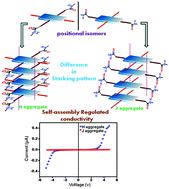当前位置:
X-MOL 学术
›
Soft Matter
›
论文详情
Our official English website, www.x-mol.net, welcomes your feedback! (Note: you will need to create a separate account there.)
Tuning of the optoelectronic properties of peptide-appended core-substituted naphthalenediimides: the role of self-assembly of two positional isomers
Soft Matter ( IF 3.4 ) Pub Date : 2021-06-25 , DOI: 10.1039/d1sm00752a Kousik Gayen 1 , Soumyajit Hazra 1 , Arun K Pal 2 , Subir Paul 1 , Ayan Datta 2 , Arindam Banerjee 1
Soft Matter ( IF 3.4 ) Pub Date : 2021-06-25 , DOI: 10.1039/d1sm00752a Kousik Gayen 1 , Soumyajit Hazra 1 , Arun K Pal 2 , Subir Paul 1 , Ayan Datta 2 , Arindam Banerjee 1
Affiliation

|
This study demonstrates how the self-assembly pattern of two different and isomeric peptide-appended core-substituted naphthalenediimides (NDIs) affects the modulation of their optoelectronic properties. Two isomeric peptide-attached NDIs were synthesized, purified and characterized. Interchanging the position of attachment of the peptide units and the alkyl chains in the NDI has altered the respective self-assembling patterns of these isomeric molecules in the aggregated states. The isomer having a peptide moiety in the core position and the alkyl chain in the imide position (compound N1) forms face to face stacking or ‘H’ aggregates in aliphatic solvents including n-hexane, and n-decane, whereas compound N2, in which the peptide moiety is at the imide position and the alkyl chain is attached at the core position of NDI exhibits edge to edge stacking or J aggregates under the same conditions as it is evident from their UV-vis studies. The H aggregated species (obtained from N1) show inter-connected nanofibers, whereas the J aggregated species (obtained from N2) exhibit the morphology of helical nanoribbons. FT-IR and X-ray diffraction studies are in favor of the same aggregation behavior. The individual packing patterns of these two peptide-based isomers have a direct impact on their respective electrical conductivity. Interestingly, the H aggregated species shows 100 times greater current conductivity than that of the J aggregate. Moreover, it is only the H aggregated species that exhibits a photocurrent, and no such photocurrent response is observed with the J aggregates. Computational studies also support that different types of aggregation patterns are formed by these two isomeric molecules in the same solvent system. This unique example of tuning of optoelectronic behavior holds future promise for the development of new peptide-conjugated π-functional materials.
中文翻译:

调节肽附加核心取代萘二亚胺的光电特性:两种位置异构体自组装的作用
这项研究证明了两种不同的异构肽附加核心取代萘二亚胺 (NDI) 的自组装模式如何影响其光电特性的调节。合成、纯化和表征了两个异构肽连接的 NDI。NDI 中肽单元和烷基链的连接位置的互换改变了这些异构分子在聚集状态下的各自自组装模式。具有在芯位置的肽部分,并在酰亚胺位置烷基链异构体(化合物N1)形式面对面堆放或“H”的聚集体中的脂族溶剂,包括Ñ己烷,和Ñ-癸烷,而化合物 N2,其中肽部分位于酰亚胺位置,烷基链连接在 NDI 的核心位置,在相同条件下表现出边缘到边缘堆积或 J 聚集,这从其 UV-vis 可见学习。H 聚集物质(从 N1 获得)显示相互连接的纳米纤维,而 J 聚集物质(从 N2 获得)表现出螺旋纳米带的形态。FT-IR 和 X 射线衍射研究有利于相同的聚集行为。这两种基于肽的异构体的单独包装模式对其各自的电导率有直接影响。有趣的是,H 聚集物显示出比 J 聚集物大 100 倍的电流传导率。此外,只有 H 聚集物表现出光电流,并且在 J 聚集体中没有观察到这种光电流响应。计算研究还支持这两种异构分子在同一溶剂系统中形成不同类型的聚集模式。这种光电行为调节的独特例子为开发新的肽共轭 π 功能材料带来了未来的希望。
更新日期:2021-07-15
中文翻译:

调节肽附加核心取代萘二亚胺的光电特性:两种位置异构体自组装的作用
这项研究证明了两种不同的异构肽附加核心取代萘二亚胺 (NDI) 的自组装模式如何影响其光电特性的调节。合成、纯化和表征了两个异构肽连接的 NDI。NDI 中肽单元和烷基链的连接位置的互换改变了这些异构分子在聚集状态下的各自自组装模式。具有在芯位置的肽部分,并在酰亚胺位置烷基链异构体(化合物N1)形式面对面堆放或“H”的聚集体中的脂族溶剂,包括Ñ己烷,和Ñ-癸烷,而化合物 N2,其中肽部分位于酰亚胺位置,烷基链连接在 NDI 的核心位置,在相同条件下表现出边缘到边缘堆积或 J 聚集,这从其 UV-vis 可见学习。H 聚集物质(从 N1 获得)显示相互连接的纳米纤维,而 J 聚集物质(从 N2 获得)表现出螺旋纳米带的形态。FT-IR 和 X 射线衍射研究有利于相同的聚集行为。这两种基于肽的异构体的单独包装模式对其各自的电导率有直接影响。有趣的是,H 聚集物显示出比 J 聚集物大 100 倍的电流传导率。此外,只有 H 聚集物表现出光电流,并且在 J 聚集体中没有观察到这种光电流响应。计算研究还支持这两种异构分子在同一溶剂系统中形成不同类型的聚集模式。这种光电行为调节的独特例子为开发新的肽共轭 π 功能材料带来了未来的希望。



























 京公网安备 11010802027423号
京公网安备 11010802027423号